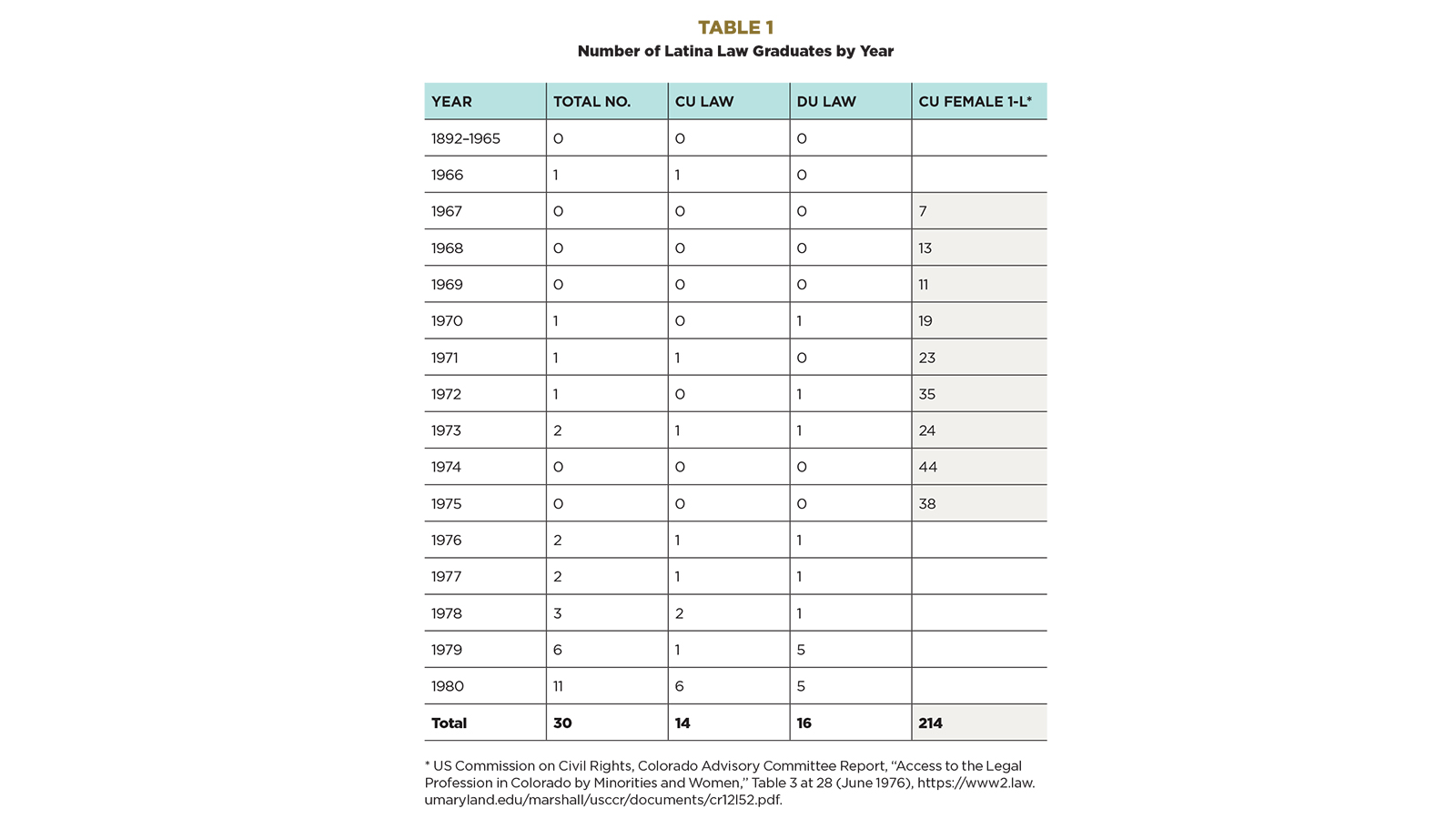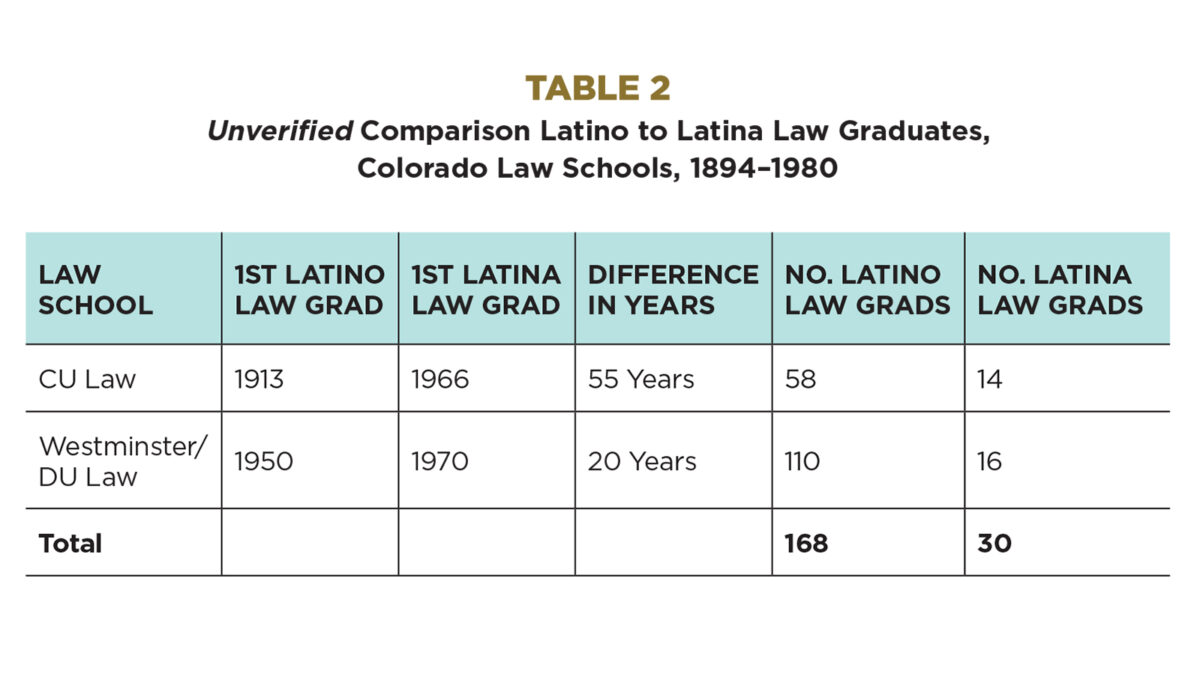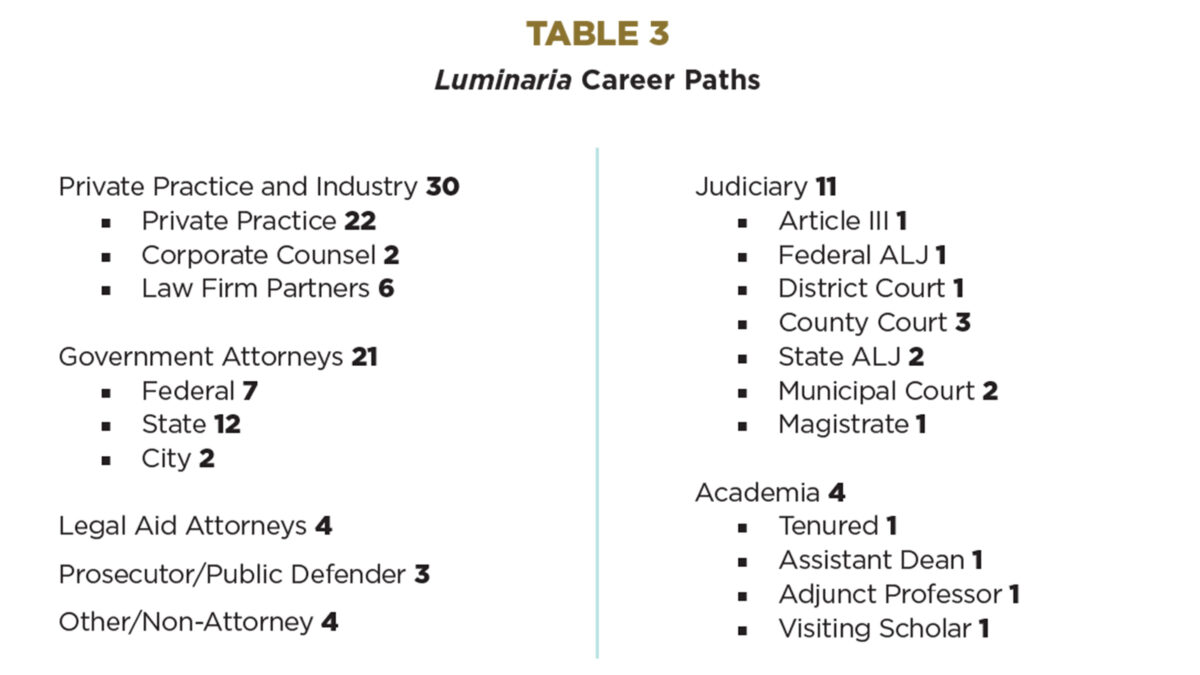
The First Latina Law Graduates and Lawyers in Colorado
June 2024
Download This Article (.pdf)
1894 was the year the first women earned law degrees in Colorado: Jeannette Dunham Bennett, University of Colorado, and Ann Hunt, University of Denver. Seven decades would pass before both law schools graduated the first Latina.
Luminarias de la Ley | Luminaries of the Law™ is a national legal history project created to identify the first Latinas who earned law degrees between 1880 and 1980 (Luminarias) and document their accomplishments. This article is the first in a series of state bar articles designed to identify and present empirical data about that state’s Luminarias. Before 1993, there was no research or literature exclusively about Latina lawyers. Despite devoting years to identify the Latina equivalent of Margaret Brent (the first woman to practice law per the ABA Commission on Women), the earliest Latina lawyers proved elusive. The task of identifying these women triggered a seven-year journey.
The Luminarias Study was a quantitative study conducted from 2016 to 2022 that included 167 ABA-accredited law schools. The Luminarias Study consisted of three phases. In Phase I, a database of female law graduates from each of the schools was compiled. Law commencement programs, cross-referenced with law alumni directories, bulletins, yearbooks, and alumni newsletters, were some of the source materials. Phase I identified 2,543 potential Luminarias. During Phase II, verification of the gender and ancestry of the 2,543 was necessary because law schools did not record the racial or ethnic heritage of law students during the 100-year study period. This process resulted in the identification of 1,347 Luminarias. The bar status and career paths of Luminarias were traced during Phase III. Key empirical research findings were published by UCLA School of Law in September 2023 in “Luminarias: An Empirical Portrait of the First Generation of Latina Lawyers 1880–1980” (Luminarias article).1 The Luminarias Study produced a national empirical baseline on the first generation of Latina lawyers that includes their ancestry, where they were educated, and where they were licensed and practiced.
The Colorado Luminarias
Among the 1,347 Latinas identified in the Luminarias Study, 40 had Colorado connections: 30 were graduates of the University of Denver Sturm College of Law (DU Law) or the University of Colorado Law School (CU Law), and 10 obtained law degrees elsewhere but were licensed in Colorado.
Racial and Ethnic Composition
Determining who is Latina is a complex issue; the criteria and ethical considerations were addressed at length in the Luminarias article.2 The Luminarias Study included those with partial to full Latina ancestry. The breakdown of the 40 Colorado Latinas was as follows:
- Mexican—34;
- Cuban—2 (1 Cuban-born);
- Puerto Rican—1; and
- Mixed race—3 (1 Afro-Puerto Rican and 2 Latina/white).
Law Schools and Licensure—Key Findings
Though CU and DU law schools graduated their first female students in 1894, the Luminarias Study found there were no Latina law graduates over the 73-year period of 1892 to 1965, or in 1967, 1968, 1969, 1974, and 1975. The first Colorado Luminaria, Mariana Roca, earned her law degree in 1966 from CU Law,3 and the first DU Law graduate, Betty Camunez, earned her law degree in 1970, both the sole Latina law graduates that year and in the state. The Luminarias Study found that single Latina law graduates during the earliest decades was the national pattern, “replicating the experience of women lawyers in the latter part of the 19th century.”4 Over 100 years, 30 Latinas graduated from law school: 14 were graduates of CU Law and 16 were graduates of DU Law.5 Eight of the 30 were licensed in another state, and two were not licensed in Colorado.6

Number of Women Law Graduates in Comparison to Latinas
It is important to contextualize the number of Luminarias through the lens of women’s progression in the legal profession. During the first 100 years of legal education, women virtually were absent. In 1870, there were five women lawyers; in 1880, there were 200 women lawyers; and in 1930, there were 3,385 women lawyers. Until 1920, women comprised 1% of the total lawyer population and then stagnated until 1960 at 3%. In comparison, the Luminarias Study found there was one Luminaria among the “First Generation of American Women Lawyers (1880–1916).”7 Further, Luminarias constituted less than 1% of all women lawyers until 1970, when they surpassed (barely) that level at 1.04%.8
In 1970, although women accounted for 51 percent of the United States population, they were only 12.5 percent of students in law school . . . . In 1970, 5 percent of Colorado lawyers were women. [6.09% in the country]. Minorities constituted 4 percent of all lawyers in the State, and minority women were only 0.14 percent.9
Latinas were impacted by their ancestry, but to a greater extent, by the gender discrimination denying women admission to law schools and the bar. By the mid-1970s, women law students comprised 25% of the total student population at CU Law and 35% at DU Law. Table 2 provides a contrasting visual representation of the number of women 1Ls at CU Law for the years 1967 to 1975 (214), in contrast to the five Luminaria graduates from both schools over the same years. In 1980, women comprised 8% of all lawyers nationwide, while Luminarias continued to be disproportionately underrepresented at 1.47%, increasing to 2.42% by 1981.10 In 2009, the Hispanic National Bar Association (HNBA) quantified the number of full-time Latina lawyers at 25,000 and today estimates the total at 35,000 (or 2.5% of the total lawyer population). While the overall number of Latina lawyers has increased, their growth has stagnated at 2.5%, essentially the 1981 level. Given their total US population of 19%, Latina lawyers continue to be disproportionately underrepresented in the legal profession at 2.5%.
Latino Law Graduates in Comparison to Number of Latina Law Graduates
Spanish-surnamed male graduates were recorded during the Luminarias Study, but only from the year the first female graduated from the 167 law schools in the study, which, almost universally, was not the first graduating class. Thus, not all Spanish-surnamed males may have been captured during the preceding years. Their ancestry was neither researched nor verified because the focus was on Latinas. With these disclaimers, it is instructive to present the number of Spanish-surnamed male graduates in contrast to the number of Luminarias. The Luminarias Study revealed a significant nationwide disparity—triple to quadruple the number of Latino law graduates to Luminarias. Fifty-three and 20 years, respectively, separate the first Latino/a CU and DU law graduates. Twenty years is lower than the national pattern. (Westminster Law, 1912 to 1957, later merged with DU Law.11)

Licensure and Practice Areas
The Luminarias Study found that 1,188 of the 1,347 Luminarias who earned law degrees became licensed.12 In Colorado, 31 Luminarias were admitted to the bar, constituting 2.52% of the 1,188 Luminarias licensed nationwide. Of the 31 admittees, 21 were graduates of CU or DU law schools. Ten earned JDs from out-of-state law schools: Berkeley, DePaul/Chicago, Florida, Georgetown, Golden Gate, Harvard, Indiana Mauer, Stanford, and UCLA. Seven of the Colorado bar admittees were also licensed in other states, including Arizona, California, the District of Columbia, Florida, New Mexico, New York, Pennsylvania, and Texas. The empirical data on career paths includes all 40 Luminarias with Colorado roots. The number of positions exceeds 40 because most Luminarias held multiple jobs during their careers. Following the national pattern, Colorado Luminarias entered in descending numerical order: (1) private practice, some transitioning to-from government work, (2) government/public service, (3) the judiciary, and (4) the legal academy.

Among the Colorado Luminarias are (1) the first solo practitioners, Joyce Sanchez and Luz Young-Rodriguez, and (2) the first law firm partners, Angelina Irizarry (1986, Rothgerber, Appel & Powers) and Christine Arguello (1988, Holland and Hart). The first judges were: Article III Judge Arguello (2008); District Court Judge Carmen Otero (1980); County Court Judges Sylvia Manzanares (1995), Virginia Chavez (1983), and Erin Fernandez-Ely (2000); and Administrative Law Judge Antoinette Martinez (1979). In 1999, Aurora Ruiz-Hernandez became the first Latina deputy director of a Colorado agency (personnel and general services administration) after serving as a first assistant attorney general in labor and civil rights. Peggy Montaño, also a first assistant in the water section/natural resources, became a law partner after starting as a Reggie Fellow at Denver Metropolitan Legal Aid. Accomplished public defender Judy Lucero later became a writer and defense counsel on death penalty cases. Prosecutors Chavez, Fernandez-Ely, and Carolyn Carrasco and the other government attorneys, such as Denver City Attorney Jacqueline Hernandez-Berardini, were the first in their respective positions. The Luminarias Study found that approximately a third of Luminarias, like Judge Arguello, are repeat “accomplishers,” achieving milestone upon milestone (an occurrence attributable in part to their unique talent and drive and in part because the times demanded their leadership). Two Luminarias, Ruth Casarez and Linda Leon, were incorporators of the CHBA13 in 1977. Casarez became the CHBA’s first female president (1979, 1980), followed by Luminaria Atencio in 1991 (also HNBA president, 1991–92) and Montaño in 1995.14
Unsurprisingly, the Luminarias Study found a natural connectivity between today’s Latina lawyers and Luminarias—specifically, career paths. Younger generations enter certain sectors (e.g., government service) in greater numbers and navigate more fluidly because of the paths forged by Luminarias. Or, in other sectors (e.g., the corporate sector, law firms, and the legal academy), due to the exclusion of Luminarias, Latina lawyers encounter residual barriers to success.15 For example, the Luminarias Study documented few tenured Luminaria professors, none of whom were appointed dean of a US law school, though there were Luminaria assistant deans. Indeed, only one Colorado Luminaria, Christine Arguello, became a tenured law professor. Currently, there are six Latina deans (nine over 126 years of legal education since Ellen Spencer Mussey became the first female dean in 1898).16 Fifty-eight Luminarias were corporate counsel, with a handful becoming general counsel (GC). In 2023, there were 14 Latina GCs in Fortune 1000 companies (up from four in 2008), and less than 1% of all equity partners in large law firms were Latina.17 In comparison, Latinas comprise 3% of the US judiciary and, while disproportionate to their 9% population rate, this percentage surpasses most other sectors, traceable to the success of Luminarias in the judiciary.
It is refreshing to report that, despite their disproportionate numbers, the succeeding generations of Latina lawyers have equaled or surpassed the accomplishments of Colorado Luminarias with broader success across more segments of the profession.18 In Colorado, there are 1.2 million Hispanics, representing 22.5% of the state’s population. The precise number of Latina lawyers is difficult to quantify due to the pattern by reporting agencies to subsume the number of Latinas (or women of color) into the broader categories of Latino/male attorneys of color and/or women.19 According to the Colorado Office of Regulatory Counsel 2022 Report, Latino attorneys constitute 7.59% of lawyers. Applying the HNBA national average of 2.5%, there are 705 Latina attorneys among the 28,218 active Colorado lawyers.20 With more precise reporting, the interconnectivity between Luminarias and today’s lawyers (the Luminaria effect) in Colorado could be more accurately studied and defined. Like the Luminarias, the gains made by Latina lawyers—despite or because of their disproportionate representation—are to be commended and supported.
Conclusion
With the youngest Luminarias now 67 or 68 years of age, most Luminarias, including those in Colorado, are retired. Seven remain actively engaged within the profession or in other work. Four Colorado Luminarias have passed before and since the Luminarias Study was launched. This article presents a sketch empirical portrait of the 40 Luminarias who broke through seemingly insurmountable barriers to become the first Latina lawyers in Colorado over the 100-year period of 1880 to 1980, leaving for future writings their impact on the Colorado legal profession and community. The indomitable spirit of the Colorado Luminarias, combined with their accomplishments, will surely continue to motivate and touch the lives of younger generations to follow.
Notes
1. See Atencio, “Luminarias: An Empirical Portrait of the First Generation of Latina Lawyers 1880–1980,” 39 Chicanx-Latinx L. Rev. 1 (2023), https://escholarship.org/uc/item/43f12635. The full Luminarias Study is on file with the author.
2. Id. at 16–30.
3. In previous writings, Betty Camuñez was identified as the first Latina lawyer in Colorado. This was updated in the Luminarias Study based on its criteria for determining who is Latina.
4. Atencio, supra note 1 at 51–52.
5. Atencio, supra note 1 at Appendix A, Luminarias by State and School. This number was updated from 15. The research is fluid.
6. Research began with the name listed at graduation thereafter matched to state bar records. When a Luminaria was not found, additional research was required, which proved difficult. It was not uncommon, through circuitous research, to find that Luminarias changed surnames through marriage or divorce. See Atencio, supra note 1 at Appendix C, Methodology.
7. The phrase “First Generation of American Women Attorneys” was coined by Jill Norgren in “Ladies of Legend: The First Generation of American Women Attorneys,” 35 J. of Sup. Ct. Hist. 71 (2010).
8. Atencio, supra note 1 at 32 and sources cited, especially Cynthia Fuchs Epstein and Jill Norgren.
9. Atencio, supra note 1 at 4.
10. Atencio, supra note 1 at 32–33. See Table 1, Women Lawyers and Luminarias by the Numbers, 1880–1980.
11. Former DU Law Dean Robert Yegge started a special admissions program to admit Latinos in 1967 (as did CU Law) that later was expanded to other students of color. DU Law Progress Report to the Ford Foundation Law School Preparatory Program for College Graduates of Spanish-American Descent (Sept. 1, 1967), https://files.eric.ed.gov/fulltext/ED021682.pdf. See also https://www.law.du.edu/about/history.
12. Atencio, supra note 1 at 56.
13. Formerly the Chicano Bar Association.
14. CHBA, Mission and History, Past Presidents, https://chba.net.
15. Atencio, supra note 1 at 60–74, C. Luminaria Career Paths and Milestones: Chosen or Imposed?
16. In 2023, the HNBA created a Special Committee on Hispanic Faculty and Law Deans to address the problem. See https://hnba.com/special-committee-on-hispanic-law-faculty-and-deans/#. The Graciela Olivarez Latinas in the Legal Academy (GO LILA) at https://conferences.law.stanford.edu/go-lila-workshop-2023.
17. Atencio, supra note 1 at 60–74; Cruz, “Still Too Few and Far Between,” AC HNBA 2023 Noticias 8–10, https://www.dropbox.com/scl/fi/kc05to5dhal32i9kiwiy1/AC2023-Program092123.pdf.0.
18. Office of Attorney Regulation Counsel, 2022 Annual Report, Appendix A, Table A-2: Race/Ethnicity/National Origin, at 46, https://coloradosupremecourt .com/PDF/AboutUs/Annual%20Reports/2022%20Annual%20 Report.PDF.
19. Accord ABA 2023 Profile of the Legal Profession, Demographics, https://www.americanbar.org/content/dam/aba/administrative/news/2023/potlp-2023.pdf.
20. Upon conferring with CHBA President Amber Gonzales, we estimate the number closer to 500, considering self-identification and the increase of Latina law students since 2009.


